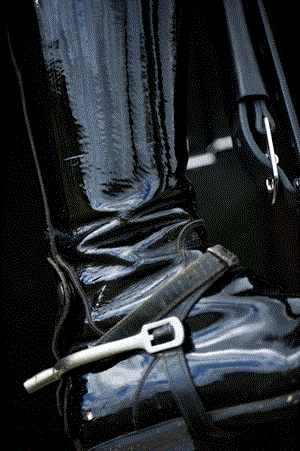Q: Why would a rider choose shorter spurs over longer ones? Are the long ones for advanced riders and short ones for beginners? If not, in which situations would you use long spurs, in which short ones? I’m an intermediate rider (schooling Second Level). Which length would you recommend? Also, when should I use sharp, pointy spurs and when do I opt for gentler, softer ones?
A: If you open the pages of any tack catalog, you will notice that spurs come in many different shapes and sizes: dull and sharp, long and short, metal and plastic and now even straight and sideways (the rowels that is). The spur is a tool, as are the saddle, bridle and whip, and can be used to affect the horse’s response and to refine, reinforce and reward—I call them the “Four Rs.” I am assuming by the nature of your question that you are ready to begin to ride with more precision. Therefore, you are looking for something to help you achieve that goal. I would like to share a few thoughts about the reasons you would choose to ride with spurs.

Response: Usually the first reason why you may want to use spurs is to achieve a better reaction to your leg. Even with the most competent rider, a horse may become dull to the leg. It is important to remember that most horses by nature take the path of least resistance to some degree. A spur used for response helps the horse notice that the leg has been applied and that you are expecting a reaction.
Reinforce: Spurs can be useful in reinforcing a specific aid. In the case of a dull horse, after applying the leg and getting an insufficient forward reaction, the spur could be used to reinforce that the leg means to move more forward.
Refine: Some advanced riders use spurs to allow their legs to make smaller movements to achieve more precise reactions. For example, during a flying-change aid, if a
horse was swinging sideways due to being overly reactive to leg pressure, a quick pulse with the spur may help to straighten him and quicken the change. A spur used in this way allows the rider to use less leg pressure, thereby refining the change aid.
Reward: In the case of sensitive or more advanced horses who do not like to be ridden with a significant amount of leg pressure, the spur can be used to thank the horse for being so responsive. These types of horses often appreciate the clarity of an aid that a properly applied spur can provide.
As a trainer and clinician, I am frequently asked questions about spurs. First, before allowing a student to use spurs, I make sure the rider has independent hands, seat and legs. The point of having an independent leg, seat and hand is that you are able to apply one aid without negatively impacting the other(s). If your seat is stable only because you are gripping with your lower legs and hanging on the reins, you are not ready for spurs.
Then I determine whether the horse accepts the legs (the horse is comfortable with the rider’s legs gently lying on his sides and moves forward when the legs are applied) and whether the rider/horse combination has a basic knowledge of rhythm, suppleness and connection. You need this basic knowledge so that the application of the spur will enhance the horse’s understanding of these qualities in a calm and quiet manner. If this groundwork has not been established, a spur will only complicate and confuse the horse. Lastly, I use the Four Rs to identify specifically why the rider wants to use spurs.
For the choice of spur type and length, I use this golden rule: Use as little as you have to but as much as you need. I would start small and dull (5 mm) and then progress to 15 mm after a few rides, but only if you did not get the desired reaction from the smaller spur.
For the beginner rider, the spur should be used to turn up the volume of the leg aid. For example, encouraging the horse to move more forward toward the bit or getting him to step more deeply sideways in a leg yield. The intermediate rider may be using the spur to help the horse understand impulsion, straightness and the beginnings of collection.
The length of the spur is not always proportional to the level of the rider; it is more related to the reactivity of the horse. If you are a beginner and have a dull horse, you may need to get a greater response by using a longer spur to reinforce your leg. Conversely, an advanced rider on a hot horse may need only a small, dull spur to refine the aids of the leg.
In the case of sharp or pointy spurs, I believe they should be reserved for special cases and used only by advanced riders—someone who has complete control of his or her body and has a clear understanding of the dressage training scale. Remember that using spurs should ultimately give your horse a clearer understanding of what you are asking him to do. Choosing wisely and using prudently will ensure that your horse is a happy athlete as you progress up the levels together.
John Zopatti is a USDF gold medalist and an “L” Education Program graduate with distinction. He’s also a four-time Gold Coast Dressage Association Trainer of the Year. He spends his summers in Pinehurst, North Carolina, helping several successful eventers gain an edge in dressage.











